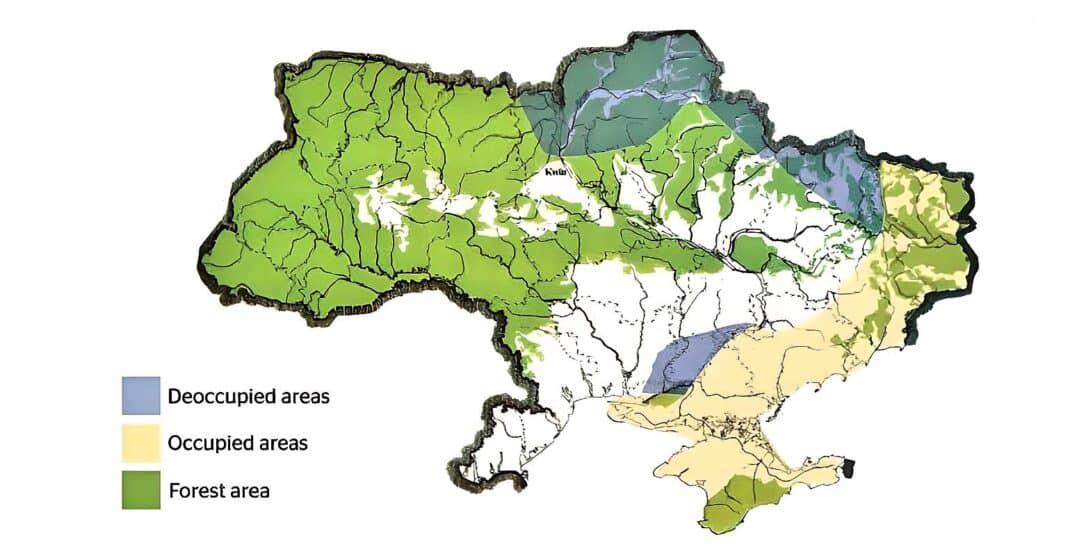The resilience of Ukraine’s forestry in the face of the Russian invasion is remarkable. Still, the country requires greater access to humanitarian, military and financial support to rebuild critical infrastructure and industry.
Ukraine has the potential to be a global power for forest products. Since 1961, the forest cover has increased by 1.5 times and now covers 15.9% of total land cover.

By the numbers, Ukraine has 10.4 million hectares designated for sustainable forest management, with 87% of forests State-controlled.
It has a large share of lucrative middle-aged trees strongly influenced by reforestation in large clear-cut areas after the Second World War – most trees are pine, oak, beech, spruce, birch, alder, ash, and hornbeam.


The growing stock is estimated to be 2.1 billion cubic metres, with an annual increment of around 35 million cubic metres.
In fact, of the 160 million hectares of global forests certified by FSC, more than 4.19 million hectares are in Ukraine. PEFC, which has operated in the country since 2021, has 120,900 hectares, growing fast, primarily in Western Ukraine.
With the New York Times reporting total causalities from the conflict have surpassed 500,000, Forest Europe is working with Ukrainian government agencies to rebuild Ukraine’s forest industry.
Forest Europe supports investment in Ukraine’s forest industry
A new report published last month, ‘Supporting the recovery and sustainable management of Ukrainian forests and Ukraine’s forest sector,’ looks at the next steps.
Supported by a global network of forest experts, the report strongly supports EU accession and “to maintain and strengthen cooperation with forest-related international organisations.”
It supports engaging with “environmental NGOs, research institutions” and strengthening relationships with the Official Development Assistance (ODA) and other forest-related funding mechanisms.
The report states that the FAO and UNECE are key players, with the UNDP, World Bank, and EUSTAFOR critical in providing Ukraine with resources to rejuvenate its industry.
However, it notes that “forestry is not considered a priority in the recovery process either at the national, international level” and that it must instead “focus on experience exchange and bilateral cooperation.”
According to the report’s leading author, Liubov Poliakova, the war has “significantly damaged forests and other natural landscapes, compromising the possibility of forestry activities in the country.”
War Impact: Almost 3.5 million forests damaged by conflict
In total, 2.9 million hectares of forest have been affected by military activities since the start of the current conflict.
In addition, just under 500,000 hectares of forests are under Russian occupation following Russia’s invasion of Crimea in 2014.
Occupied forest areas and forest areas on the front line, in May 2023, correspond “to more than 1 million hectares of areas designated for sustainable forest management.”
The report found heavy disturbance of aboveground ecosystems, soils and water systems due to heavy military equipment, military units and armed conflict.
Therefore, the accumulation of solid waste, military equipment and human and animal bodies has significantly impacted forest health.
Protected ecosystems under Russian occupation
Russia still occupies large swaths of protected Ukrainian ecosystems.
Occupied territories include 16 Ramsar Sites, 600 species of animals and 160 territories of the Emerald Network – which amounts to just under 3 million hectares of land.

According to research by the Ukraine War Environmental Consequences Work Group, at least 100 thousand hectares of the Emerald Network have been damaged by forest fires connected to the conflict.
The report alleges heavy metal concentrations in soils are over 15-30 times higher in military zones.

In March, Wood Central reported that woodland trees and areas destroyed by shelling and bombs would take decades to grow back.
In addition to soil and fire, the report notes the movement and destruction of military equipment, construction of fortifications and mining protected forests on the Belarussian border as significant contributors to forest destruction.
And then there is Chornobyl
“The nuclear radiation issue is due to the Russian troops driving their armoured vehicles without radiation protection through the Red Forest,” the report said.
The Red Forest is the most radiated area in Chornobyl, with Russian invaders’ reckless and unsafe practices leading to an elevated risk of radioactive dust.
“The radiation content in the atmospheric layers increased and moved to other areas through air masses.”
In addition, radioactive dust settled on the Russians’ equipment and vehicles and was transported to other zones.
“The Russian military began to build fortifications on the territory of the Red Forest, thereby increasing the risk to people and the environment due to the highly radioactive dust in the soil’s deeper layers.”
Ukraine’s Three Billion Tree Plan
Before the conflict, Ukraine invested heavily in afforestation and reforestation to meet climate targets.
In June 2021, President Volodymyr Zelenskyy signed a decree launching the ‘Green Country’ project.
“I will say at once that this is not a political project but a purely ecological one for nature and the environment,” President Zelenskyy said.
“We have set ourselves an ambitious but, I am sure, achievable goal – to increase the area of forests by one million hectares in 10 years. To this end, in the next three years, we seek to plant one billion trees in Ukraine.”
Remarkably, “despite the war and its consequences, the forest sector in Ukraine is continuing to fulfil its planting obligations.”
The State Forest Resource Agency controls the planting, with the State increasing seedlings and soil production to meet targets – even during heightened war conditions.
In 2022, Ukraine planted 200 million additional trees with three new facilities in Zhytomyr, Ivano-Frankivsk and Kiorobogradregion.
Up to 50% of Ukrainian processors have closed production
Yet despite extensive planting, the blockade of Black Sea ports led to the closure of Asian markets for Ukrainian exporters.
Other challenges include the ban on roundwood export and “logistical problems in exporting process timber and timber products.”
According to Mr Poliakova, Ukraine experienced a 30% reduction in roundwood prices last year.
Like Russia, the war has hit Ukraine’s timber harvest, with volumes dropping 10% in 2022 – from 17.6 million cubic metres to 15.9 million cubic metres.
In unoccupied territories, reductions in the total volume of harvested timber are even higher. In Kharkiv, timber harvesting contracted by 48%, in the Chernihiv region by 30%, and in the Kyiv region by 33%.
Overall, the total volume of timber sales decreased by 1.813 million cubic metres, and as a result, the revenue of state forest enterprises declined by 80 million euros.
Considering the decreased prices of timber sold, the total unreceived income from timber sales amounted to 142 million Euros – or about 57.5 million Euros in lost taxes.
According to Mr Poliakova, up to 50% of Ukrainian processors have closed production.
Frequent power outages increased the cost of production, and a drop in demand for processed timber was identified as a significant barrier to reconstruction.
However, Mr Poliakova notes “the drastic damage and destruction of real estate and equipment” has limited the reconstruction of the forest sector in the medium and long term.
In addition, the destruction of the Forest Management Planning Association “has made it impossible to make timely amendments to forest management plans.”
Forest Europe has identified several key priorities
Amongst immediate priorities includes “assessing and demining forest areas” and urgently accessing forest areas that have been active war zones.
Longer term, the reports provide recommendations around planning, governance, protection, digitalisation, education and research.
It also advises that the loss of biodiversity and forest ecosystem services “require complex restoration and rehabilitation processes.”
Ukrainian forestry has limited access to external financial sources due to many issues, including “eligibility issues, language barriers, a heavy administrative and bureaucratic burden.”
The report claims that Ukraine, as a country, and the Ukrainian forest-related administration can only solve the challenges with significant international support and aid.
Significant international humanitarian and military support, far more than currently committed, will be required to rebuild Ukraine’s critical infrastructure.
However, destroying the Ukrainian infrastructure allows the industry to build back better, focusing on experience exchange and bilateral cooperation.
“New and modern practices in forest management planning and monitoring,” including digital solutions, can be further developed in the country.
Due to the extent of environmental damage, the report concludes that “forest recovery should be considered a cross-cutting issue involving different agencies.”
“This ensures a comprehensive landscape approach and financial incentives for the forest sector and beyond.”






